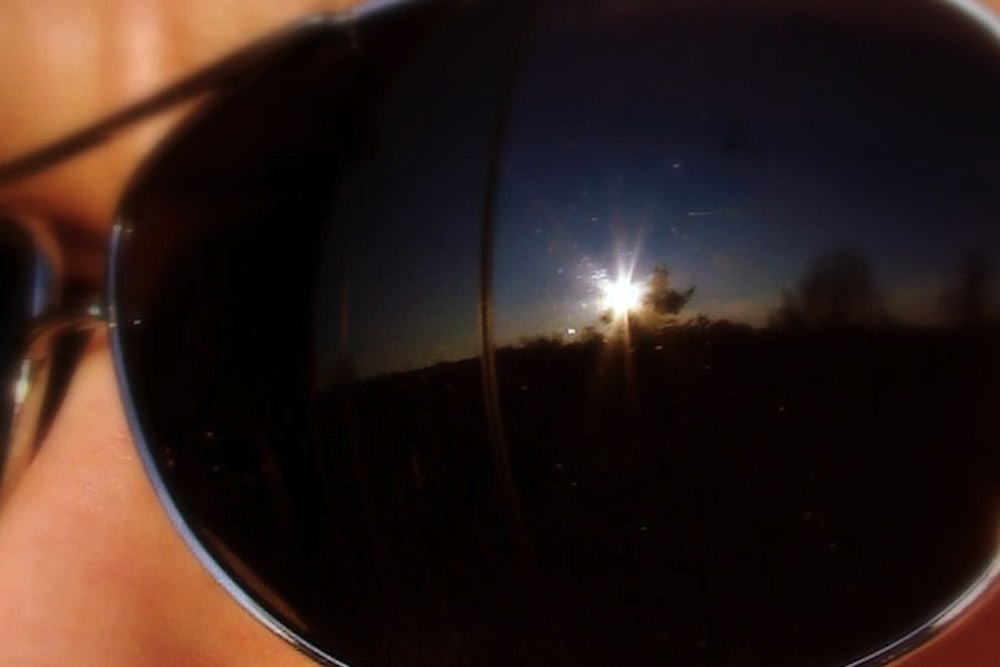After one of the longest winters in recent memory, the sun is finally coming out—and for the fashion-conscious and the wrinkle-fearing, that means the beginning of sunglasses season. As if shopping for sunglasses weren't daunting enough—can you pull off colored lenses? Do aviators make you look like a douche?—here’s something else to consider: Big sunglasses could make you less generous. Anonymity is disinhibiting—and by obscuring one of the most identifying facial features, sunglasses provide some measure of it.
In 2010, researchers at the University of Toronto designed an experiment looking at the effects of sunglasses on moral behavior. In a study that ended up in the journal Psychological Science, a team of social scientists led by Chen-Bo Zhong recruited around 80 volunteers and assigned half to wear sunglasses, half to wear clear glasses. Participants were then given $6 to divvy up between themselves and a confederate in another room. The people wearing sunglasses were, as Zhong anticipated, significantly less generous: On average, they opted to give the stranger $1.81, compared to $2.71 for the group in clear lenses. Zhong also looked out how putting on sunglasses altered people’s sense of anonymity during the experiment, and found that people in sunglasses admitted to feeling more anonymous: On a scale of 1 to 7, they rated their sense of anonymity as 4.7, while those in clear glasses ranked their anonymity as 4.

Zhong’s findings fit with the conclusion of a more prominent study. In the infamous Stanford prison experiment in 1971, psychology professor Philip Zimbardo recruited 24 physically and mentally healthy adult men and assigned half of them to act as prisoners and half as guards in a simulated jail he built in the basement of Stanford’s psychology building. Zimbardo and his team planned to observe the psychological changes that would take place over the course of two weeks—but the behavior of the men assigned to impersonate wardens became so sadistic, and the prisoners’ mental health so compromised, that he brought the experiment to an end after just six days. One of the key tools Zimbardo used to transform the ordinary men acting as “guards” into monsters? Mirrored sunglasses.
Sunglasses don’t confer as great a degree of anonymity as masks, but there’s a larger body of evidence showing masks’ detrimental impact on moral behavior. Throughout history, governments have regulated masks in the interest of maintaining public order. In the 12th century, Pope Innocent III banned masks as part of a crackdown on immorality among the clergy. In 1845, New York State made it illegal for for three or more people to wear masks in public, after farmers in the Hudson Valley dressed up as Native Americans and attacked and killed their landlords. Around the world, people don masks for rituals and ceremonies requiring them to let loose—from the violent masked clowns of the Mexican Yaqui Pascola to the revelers at Carnival celebrations across Europe.
In the past few decades, social scientists have contributed empirical data showing that masks make people more likely to violate rules and norms. In 1979, Purdue University psychologists Franklin Miller and Kathleen Rowold looked at how putting on a mask affected the chance of children breaking rules by tracking the behavior of 58 kids on Halloween, some of whom wore masks as part of their costumes. The children were offered a bowl of candy and told they could take two pieces, and, as they expected, the kids in masks were way more likely to take more candy than they were supposed to: 62 percent of the children in masks broke the two-candy limit, compared to 37 percent of those whose faces were visible.
In an experiment in 1976, Eugene Mathes and Thomas Guest, psychologists at Western Illinois University, explored how wearing a mask would affect college students’ willingness to walk around their campus cafeteria carrying a banner reading, “Masturbation is fun.” Some students were told that they could wear a ski mask that would cover their entire head except their eyes, while others weren’t given that option. Unsurprisingly, the ones who were allowed to wear a ski mask were willing to carry the sign for much less money: $29.98, on average, versus $47.92. So unless you anticipate needing to break social conventions or short-change your friends this spring, I'd stick to small frames and light lenses.
